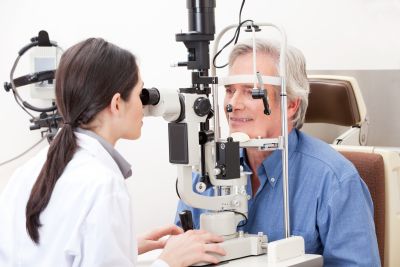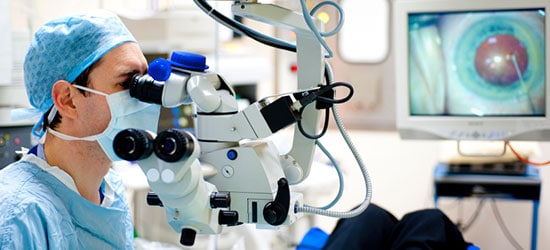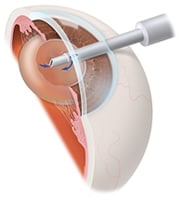As we age, our vision can be affected by cataracts. Although more common in elderly patients, cataracts can affect the vision of young adults as well.
Dr. Jean E. Keamy, M.D., M.B.A., and her team at Keamy Eye & Laser Centre are proud to help patients in Westborough, MA, improve their vision for good by providing high-quality care and cataract surgery to patients experiencing cataract symptoms.
What are cataracts?

A cataract is a painless clouding of the eye’s natural lens. The cloudiness develops as a result of protein buildup in the lens. Cataracts can occur in either one eye or both eyes and affect millions of people each year.
This condition is most likely to occur in patients over the age of 60. At Keamy Eye & Laser Centre in Westborough, MA, we will diagnose and treat your cataracts to improve your quality of life.
Watch the following videos to learn more:
What causes cataracts?
The lens within the eye clouds naturally as we age, causing a gradual reduction of vision. There are numerous other causes of cataracts, including:
- Alcohol use
- Diabetes
- Exposure to radiation
- Family history of cataracts
- Illness
- Injury
- Medication
- Prolonged UV light exposure
- Result of eye surgery
- Smoking
What Are Cataract Symptoms?
Cataracts can be present without patients even knowing. Typically patients do not realize they have cataracts until their vision is affected. Symptoms of cataracts include:
- Blurry, cloudy, or misty vision
- Decreased color perception
- Difficulty reading
- Double vision
- Frequent changes in the lens prescription
- Poor night vision
- Small spots, dots, or halos
- Vision worsens when lights are dim, very bright, or there is a glare
Watch Dr. Keamy Explain The Symptoms of Cataracts
How Are Cataracts Diagnosed?
Whether or not patients are experiencing symptoms, there are a series of tests that Dr. Keamy can perform to diagnose a cataract. The degree of visual impairment determines the treatment method, therefore, early detection can allow patients to avoid surgery. To diagnose cataracts patients can go through a dilated eye exam, visual acuity test, tonometry, or slit-lamp examination. Alone or in combination, these tests can determine if a patient has cataracts or their symptoms are a result of a different condition including glaucoma or macular degeneration.
Laser Cataract Surgery Testimonial
"Dr. Keany is a great surgeon....today she removed my second cataract in 3 months. She is professional and very knowledgeable. Her human demeanor and compassion make for a very pleasant experience under her care! I do not hesitate to recommend her for your personal health needs. The office staff is the best, also."
What is cataract surgery?

Cataract surgery is a minimally invasive procedure to remove cataracts. Surgery is typically performed on an outpatient basis using local anesthesia.
During cataract surgery, the natural cloudy lens of the eye is replaced with a clear artificial lens. The artificial lens, known as an intraocular lens, improves vision. Cataract surgery is a common procedure that is considered safe and effective.
What's The Average Age for Cataract Surgery?
Although cataracts are mostly common in older people, it is true that young children, middle-aged adults, and even babies can experience cataract symptoms. While cataract surgery is recommended mostly for adults 21 and over, it can be helpful to regularly schedule appoints with your eye doctor to monitor changes in cataract symptoms in young people.
In the United States, most people begin to develop cataracts around the age of 60, making the average age for a patient undergoing cataract surgery 73 years old. However, if you experience worsening cataract symptoms at an age younger than 73, consult with Dr. Keamy or your primary eye doctor to find out whether cataract surgery can benefit you.
Traditional Cataract Surgery
At Keamy Eye & Laser Centre we perform a minimally invasive, small-incision, no-stitch cataract surgery called phacoemulsification, also known as phaco surgery. First, Dr. Keamy will dilate the pupil and numb the eye with anesthesia. Then, a tiny incision is made to insert the small ultrasonic probe. The probe breaks up or emulsifies, the cloudy lens into tiny pieces which are then suctioned out. After removing the natural lens, Dr. Keamy will place the intraocular lens or IOL. There are a variety of IOLs and the appropriate type will be determined during your consultation.
Once the IOL is in place surgery is complete. Due to its small size, the incision will be able to heal on its own with only a topical eye drop. Therefore, there are no injections or stitching in the eye at all. The whole procedure takes about 30 minutes and patients can typically leave the facility after their surgery.
Dr. Keamy Explains Cataract Surgery
Watch the following videos to learn more:
What is laser cataract surgery?

While traditional cataract surgery can provide patients with the improved vision it does not provide the precision and customization that comes with laser-assisted cataract surgery. At Keamy Eye & Laser Centre, we use the Catalys system from OptiMedica for laser-assisted cataract surgery.
The Catalys system is the only laser system created specifically for the surgical treatment of cataracts. Instead of just measuring and mapping the eye, the Catalys offers advanced optical coherence tomography to obtain much more detailed, high-resolution images of the eye.
Prior to surgery, Dr. Keamy will take all of the information provided by these images and design a personalized surgical plan for the patient’s unique eyes. The Catalys system additionally features state-of-the-art image guidance technology that recognizes the various surfaces of the eye and generates safety zones that help Dr. Keamy determine the optimal location for an incision and target the treatment area precisely.
Watch the following videos to learn more:
Should I Get LASIK After My Cataract Surgery?
If you are starting to notice that you need reading glasses or that street signs are out of focus, you may be a great candidate for LASIK laser vision correction. People who've had cataracts removed have new lenses. These may even have some magnification to correct certain visual errors. However, having new lenses does not mean your vision can't change over time. Refractive errors, those that are corrected with LASIK, occur in the cornea of the eye. So, if you'd like to have your clear vision restored in a different way than cataract surgery helped, you can benefit from talking to your board-certified ophthalmologist about LASIK.
How Long Do I Have to Wait After My Cataract Surgery to Get LASIK?
You might be a candidate for LASIK within a couple of months of having your cataract surgery. The LASIK procedure involves a tiny incision to create a flap through which the cornea can be accessed. The doctor uses a femtosecond laser to create this flap, then an excimer laser to reshape the cornea. Reshaping the cornea allows light to pass through the eye more directly, and to land on the cornea in a more organized way so transference of signals to the brain is clearer. Clearer signals to the brain result in clearer visual images.
What is the Recovery Like After LASIK?
The LASIK procedure is precise and conservative. There is very little downtime associated with this eye surgery. Initially, your eyes may feel irritated and itchy. This is a result of the inflammation that occurs after laser treatment. If you feel uncomfortable, you can take an over-the-counter pain reliever as directed. To reduce the short-term irritation, we suggest avoiding screen time, reading, and other activities that may strain your eyes. You may also be more sensitive to light for a few days, which could be exacerbated by using the computer or watching television. Your aftercare instructions may recommend using eye drops to maintain moisture and help manage irritation.
We'll check up on you in the days after your LASIK procedure, but please feel free to contact the office if questions arise before you hear from us! In the weeks following your procedure, you may need to wear special protection or refrain from certain activities, such as contact sports. Our team is here to help you navigate your recovery with comfort and ease.
Will I Still Have to Wear Glasses After LASIK?
Studies indicate that over 95 percent of patients treated with LASIK no longer require eyeglasses. That said, the eyes can continue to change through the aging process. This means that there may come a time years after the LASIK procedure when reading glasses or distance glasses become necessary.
Can LASIK Affect the Results of My Cataract Surgery?
No. The LASIK procedure is performed on the eyes' corneas. The corneas are two layers of tissue above the lens, where your cataract surgery took place. The precision of the lasers used during your LASIK procedure maintain focus on the superficial tissue alone, leaving your IOLs intact.
Are there any Risks from LASIK Vision Surgery?
LASIK is considered a safe and effective eye surgery. According to statistics, the complication rate of this vision-correcting surgery is less than 1 percent. That said, there are risks that your ophthalmologist will take into account when planning and performing your treatment. LASIK risks include glares and halos, dry eyes, visual disturbances like double vision, corneal inflammation, and over- or under-correction. Your doctor will discuss the risks associated with your procedure and is happy to answer questions regarding treatment protocols used to reduce those risks.
What results can cataract surgery achieve?
After the cataract was successfully removed it restores vision in the majority of patients who have the surgery.
Recovery from Cataract Surgery
After surgery, patients are required to wear an eye patch or protective shield for several days. Vision will be blurry at first but improves in the days following surgery. In the case that both eyes have a cataract, which is common, surgery is done on one eye at a time. Surgery for the second eye is typically scheduled a month or two later to ensure the first eye is fully healed.
What happens if cataracts aren’t treated?
If cataracts are left untreated, the condition will worsen over time and can lead to permanent vision loss or even blindness.
Schedule A Consultation for Cataract Surgery in Westborough, MA
As a board-certified ophthalmologist and a member of the American Academy of Ophthalmology and the American Academy of Cosmetic Surgery, Dr. Jean E. Keamy, M.D., M.B.A., leads a dedicated team of professionals who are prepared to help you improve your vision for good. If you are experiencing any cataract symptoms or want to learn more, schedule a consultation at our office in Westborough, MA, by calling 508.836.8733. To learn more about cataract surgery, click here.
